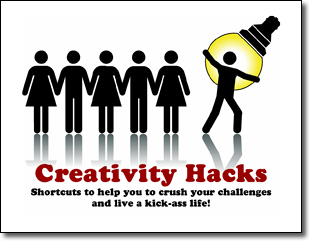Serendipity can often be a pathway to creative breakthroughs. Random stimuli leads our thinking away from familiar paths and incremental ideas – and toward profitable new adventures, perspectives and insights.
So why don’t we employ serendipity more? Perhaps because we don’t know how to cultivate it. A Google search reveals that plenty of people are extolling the virtues of serendipity, but few people are explaining how to go about it.
Here are 10 ways you can summon serendipity on demand:
1. Ask smart questions about incoming stimuli
As you encounter information and stimuli throughout your day, get in the habit of asking “how can I use that?” Or “How can I adapt that to my needs?” Remember, the basis of creativity usually isn’t coming up with blue-sky ideas – more often than not, it’s the result of adapting a solution from one industry or profession, or creatively combining two or more existing items into a new solution or package.
2. Follow the information trail – no matter where it leads
When you are searching for information online, follow the trail of web pages and resources wherever it may lead. You’ll often be delighted by the surprises you stumble upon! Once again, look at these resources with an eye toward adaption – ask the creative questions from number 1 as you review them.
3. Seek out greater variety of stimuli
Read different types of book and magazines than you are accustomed to perusing. Seek out new experiences. Expand your network of professional contacts to include a greater diversity of people. Have lunch with someone new and learn what you can from them. Take a class. Cultivate your creativity. You get the idea: Expand your horizons. Force yourself to move out of your comfort zone.
4. Cultivate visual thinking skills
Visual thinking can help you to connect the dots, see patterns and identify emerging opportunities. Mind mapping, diagramming, sketching and sketch noting are all great techniques that can help you look at challenges and opportunities from creative new perspectives – which is often the key to solving them!
5. Look for opportunities to use metaphors and analogies in your thinking
By cultivating your ability to see connections between seemingly unrelated bits of information, you will uncover more new creative opportunities. Metaphors and analogies help us to make creative leaps by describing one thing in terms of something else that’s comfortably familiar to us. For example, at the turn of the 20th century, the newfangled automobile was often referred to as the “horseless carriage.”
6. Become an insatiable explorer
Seek out new experiences, sources of information and input. Be deliberate about it. Deviate from your predictable routines. Drive a different way home from work. Take a day trip and spend the day exploring and recording what you see and experience. Do something creative – take a class where you get to make something with your hands. Gather new experiences.
7. Take a creative excursion
Work on a problem that is unrelated to your current challenge. Once you have that solved, ask yourself what insights and lessons you can apply to your major challenge. This creativity technique side-steps the brain’s natural tendency to judge ideas, making it especially valuable.
8. Become a newsletter junkie
Subscribe to a variety of e-newsletters that curate news and articles, not just from your profession or industry but from a wide variety of sources. You never know when a random article might contain just the bit of information you need to make a critical connection or creative leap. Ideally, these publications should contain an eclectic blend of thought-provoking articles that stretch your mind in different directions. Two excellent examples to which I subscribe are NextDraft and Brain Pickings Weekly.
9. Reduce screen time
Serendipity suffers when we’re constantly “wired” – connected to our mobile and other business and entertainment devices. If we’re not checking Facebook, we’re filling our eardrums with our favorite music or watching mindless shows on our big screen TVs. We fill every waking hour with stimuli. Step away from your devices. Unplug for an hour or two. Cultivate pockets of stillness in your days where you can just “be.” When you stop filling your senses with stimuli, an amazing thing happens: They come alive, enabling you to see, hear and feel things you’ve never noticed before – simply because your brain was busy filtering out stimuli to prevent information overload.
10. Maintain a “commonplace book”
This type of notebook should be filled with quotes, diagrams, ideas and other inspiring bits that you can turn to as creative catalysts when the need arises. A commonplace book is something like a personal journal – except instead of being filled with your personal reflections, it is used as a capture device for nuggets of information that inspire you. Learn more about commonplace books and their uses here.
 Creativity Hacks will inspire you to explore in new places, to make new connections, to dig deeper and discover new insights. It will help you to seek out new knowledge and sources of inspiration - so you can profit from the opportunities all around you. When you're done reading Creativity Hacks, you'll be:
Creativity Hacks will inspire you to explore in new places, to make new connections, to dig deeper and discover new insights. It will help you to seek out new knowledge and sources of inspiration - so you can profit from the opportunities all around you. When you're done reading Creativity Hacks, you'll be:
- Empowered to solve problems and tackle challenges head-on.
- Able to see ideas and opportunities everywhere.
- Able to differentiate yourself and advance your career faster.
Above all, you'll learn that creativity is a skill YOU can cultivate!

